Where to Recharge a Fire Extinguisher & Prep Tips
Author: Omar Alonso | Editor: Omar Alonso
Review & Research: Jen Worst & Chris Miller

Imagine the scenario. A fire starts in the kitchen while you’re pan-frying a rib eye. You manage to collect your wits and reach under the sink to grab the fire extinguisher. You pull the pin, depress the handle, and nothing happens. A weak fizzle of foam comes out of the nozzle, and you start to panic. Now the question is where to recharge a fire extinguisher instead of buying a whole new, expensive one.
That’s a nightmare situation no homeowner wants to face. If you’d serviced the fire extinguisher, you probably wouldn’t have had anything to worry about. However, many homeowners neglect the servicing schedule for their fire extinguishers, and that results in terrifying results the one time when you need to use it.
So, knowing when and where to recharge fire extinguishers is a crucial part of safety practices around the home. This post gives you everything you need to know about the topic.
Where to Recharge a Fire Extinguisher
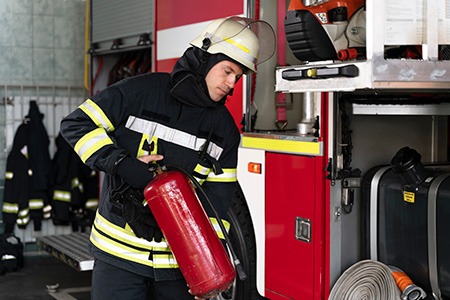
There are essentially two places to approach for a fire extinguisher recharge. It’s not a common service, so even with these places listed below you should call ahead and make sure they can do it for you.
A Fire Equipment Dealer
Check online and find a fire equipment dealer near you. Most cities have a handful of them spread throughout the suburbs and boroughs. All agents have facilities on-site to recharge the extinguisher, or they’ll send it away to a venue for servicing and refilling off-site.
In some instances, the cost of recharging the extinguisher might be close to servicing and recharging it, so you should consider buying a new one and selling the old one to the equipment dealer. While there’s nothing wrong with a recharged extinguisher, having a new one on hand in emergencies is always the better move.
The Fire Department
The next best option for recharging your fire extinguisher is to take it to the local fire department. Not all fire departments offer this service. So, call ahead and find out if they offer it before driving down there only to waste your time.
When to Recharge a Fire Extinguisher
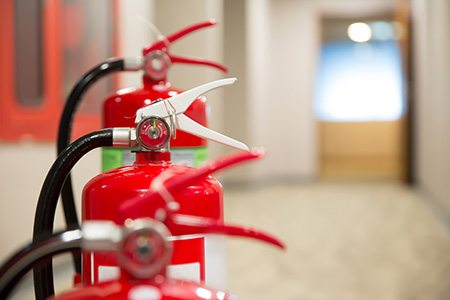
So, when do you recharge a fire extinguisher? There are a few rules to follow for correctly servicing these emergency devices. Many homeowners assume they only need to service and refill the extinguisher after they use it, but that’s not the case.
Let’s run through the scenarios where you need to recharge the fire extinguisher. Take note that you probably have a Type ABC (filled with dry chemicals) among the four types of fire extinguishers (A, ABC, BC, and K)
After Use
Obviously, if you’ve used the fire extinguisher, you need to have it recharged. Even if you didn’t use all the contents to put out the fire, you’d need to have it serviced and refilled. After using the extinguisher, you release some of the pressure in the device.
Therefore, if you try to use it again a few months later, it won’t have the same pressurized charge, resulting in the malfunction of the device when you need it most. This is a good time to check on all of your fire pit tools and other fire related items, as well.
Every Five to Six Years
Every fire extinguisher comes with a certification sticker on it. The sticker information indicates when the extinguisher was made and filled. It also shows you the kind of filler used in the device.
You’ll need to service the extinguisher every five to six years from the date of the last recharge. Sticking to this schedule ensures the extinguisher has the right pressure in the unit and the filling hasn’t expired.
If It’s Damaged
If you drop or damage the extinguisher, get it serviced. Damage to the unit might result in the failure of the seals, resulting in ineffective operation of the extinguisher when you go to put out a fire.
Recharging a Fire Extinguisher – A Step-by-Step Process
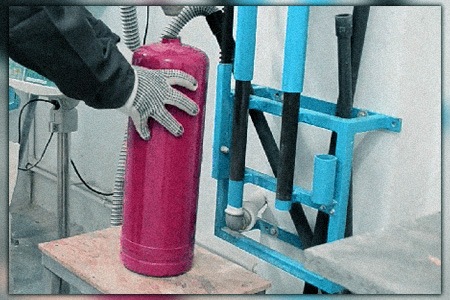
Let’s cover where to recharge a fire extinguisher and what will happen during the process.
1) Find a Provider
We recommend finding a professional, reliable service to service and recharge your fire extinguisher. A professional service has the training, experience, and equipment to ensure your fire extinguisher's correct servicing and refilling.
The provider goes through the following steps when servicing and recharging the device.
2) Removing the Remaining Extinguishing Agent
The agent will depressurize the cylinder and remove all of the fillings. They'll clean it out to ensure no filling remains in the extinguisher's body.
3) Disassembly
The agent removes the discharge valve from the cylinder, disassembling it to clean the valve.
4) Inspection
The agent visually inspects the cylinder, looking for signs of damage. They complete an inspection report of their findings.
5) Refilling
If the cylinder and valve are in good condition, they'll refill the extinguisher body with the correct filling (more on the different types of fillers later).
6) Charging
The agent replaces the seal and valve and re-pressurizes the extinguisher until it reaches a full charge pressure.
7) Leak Testing
The agent inspects the unit for leaks and completes this section of their report with their findings.
8) Reassembly
The agent reassembles the discharge hose and nozzle. They inspect these components for weathering and cracks and replace them where necessary.
9) Weighing
The agent weighs the extinguisher to ensure it meets specifications and notes its findings on the report.
10) Sealing & Tagging
The agent replaces the tamper seal to ensure you know the extinguisher is full. They attach the recharge tag with the information on the servicing date and the date for your next service of the device.
Understanding the Different Fillers in Fire Extinguishers
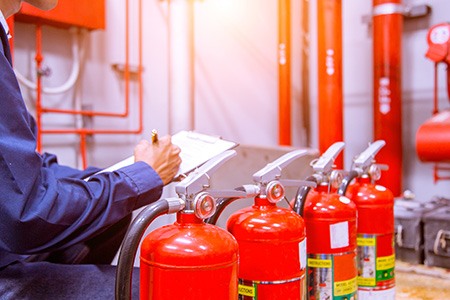
Fire extinguishers come with different fillings. Each filling has a specific purpose for use in various types of fires. Here's a quick guide to the fillers and their purpose.
CO2 – These extinguishers release cold carbon dioxide (CO2) from the nozzle. Fires require oxygen to burn. By dousing the fire with CO2, you remove the oxygen from the area, extinguishing the fire. A CO2 extinguisher effectively handles class B & C fires (electrical fires or fires started by flammable liquids).
Foam & Water – These extinguishers feature foaming agents and water filling. These fillings only suit use on class A fires fueled by flammables like wood or paper.
Wet Chemicals – The fillings in these extinguishers cool the flammable and burning materials, ensuring they don't reignite. The most common use for these types of fillers is to douse commercial kitchen fires.
Dry Chemicals – The fire extinguishers feature fillings with powdered chemicals and are suitable for use in class A, B, & C fires. The chemicals interrupt the chemical reactions that keep fires burning. These extinguishers come in cartridge-operated and pressurized models.
Clean Agents – These extinguishers release gases that don't leave any residue. They're effective at dousing most types of fires.
A dry powder extinguisher is similar to a dry chemical model. However, they're only suitable for use on class D fires involving average flammable materials.
Water mist fire extinguishers are an environmentally friendly alternative to clean agent extinguishers. They're suitable for use on class A & C fires.
The most common fire extinguisher model for office or home use is the dry chemical multipurpose model, which is suitable for use on A, B, & C fires (these fires usually involve combustible materials like flammable liquids and electronics).
What Does It Cost to Recharge a Fire Extinguisher?
Some fire extinguishers are single-use only, and you can't refill them. If you're unsure which type you have, speak to the fire equipment agent near you.
If your fire extinguisher allows for servicing and recharging, you can expect to pay between $20 to $50 for the service and refill, depending on the agent and the extinguisher size.
Prices can vary, with fire departments usually charging less for servicing and refilling extinguishers than agents. When you look up where to recharge a fire extinguisher, check there first. The price may also vary, depending on your location and the agent you use.
Tips for Using the Fire Extinguisher Correctly
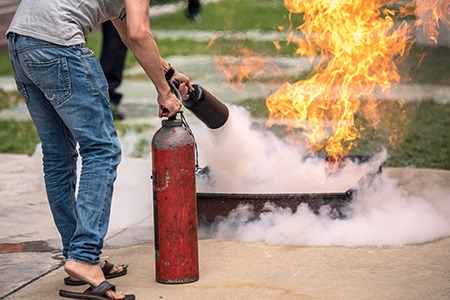
When a fire breaks out in the home, many homeowners panic. Since most people don't have any experience using these devices, they might waste valuable seconds trying to figure out how to get it going.
A simple tip for remembering how to operate the fire extinguisher is to memorize the PASS acronym. PASS stands for the following procedure.
- P - Pull the extinguisher pin
- A - Aim the nozzle at the base of the fire
- S - Squeeze the extinguisher's trigger
- S - Sweep the extinguisher in a side-to-side motion.
Only use a fire extinguisher is fires that are small and contained. If the fire looks like it's about to get out of control and block an exit, flee the area, and call the fire department. If you leave your phone in the house, go to your neighbor, and ask them to call emergency services.
Key Takeaways Regarding a Fire Extinguisher Recharge
Let’s recap the main points from above:
- If you have a fire extinguisher at home, keep the tag on the device to see when it was last serviced.
- Service the extinguisher every five to six years for best practice.
- Service and refill the extinguisher after each use.
- You can recharge the extinguisher at the local fire department or with fire equipment agents.
- There are different types of fillings to suit various fires.
- Some fire extinguishers are for single use only and can't be refilled. If you have one of these models and it's expired, you'll have to throw it away and replace it.
- The average cost of servicing and refilling a fire extinguisher is between $20 to $50. The price varies depending on who fills the device, with agents being more expensive than fire departments.
- Not all fire departments offer a refilling service for fire extinguishers.
Again, when it comes to where to get a fire extinguisher recharged, make sure you call ahead to any fire safety store or fire department to check if they can even perform a recharge for you. Now, even if it's just your fire alarm going off randomly for a few seconds, in your panic you'll know you're safe.
That’s Where to Recharge a Fire Extinguisher
You now know the types of fire extinguishers, classes of fires, where to recharge a fire extinguisher, when to get it recharged, and how much you should expect to spend. It’s not overly complicated. Just call ahead to the fire department or fire safety store so you don’t waste your time driving out there in case they don’t offer the service.



